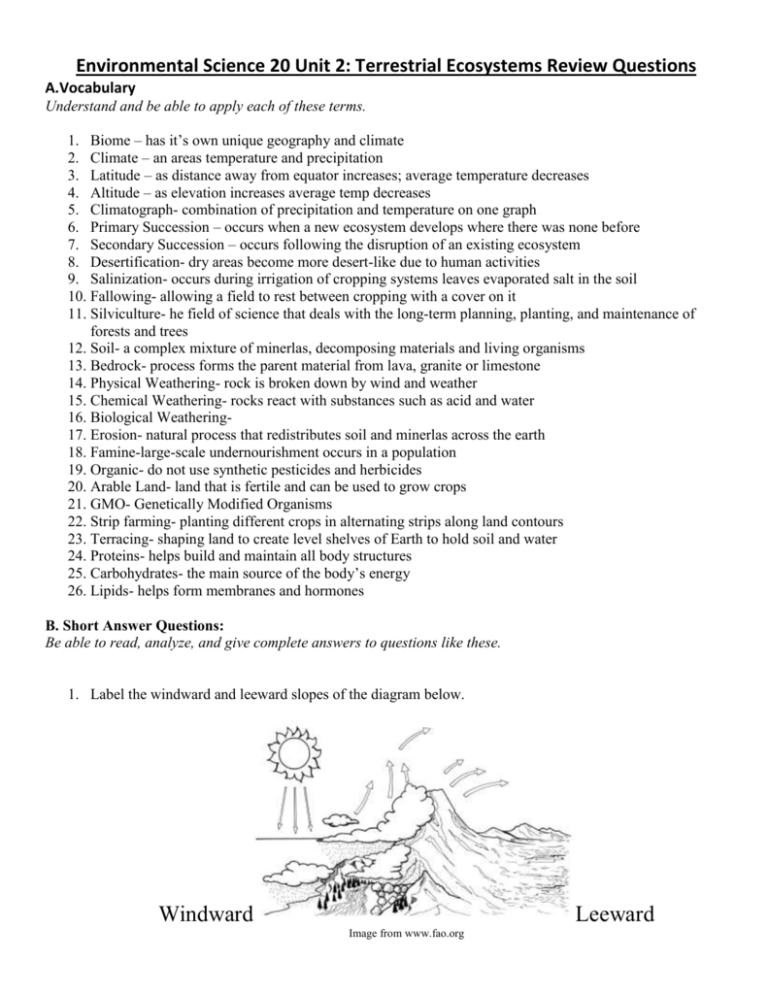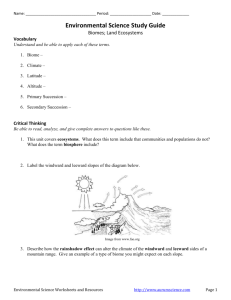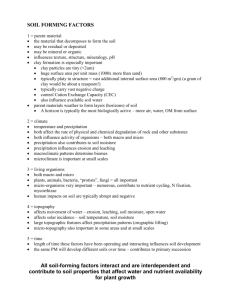Terrestrial Ecosystems Review Answer Key
advertisement

Environmental Science 20 Unit 2: Terrestrial Ecosystems Review Questions A.Vocabulary Understand and be able to apply each of these terms. 1. Biome – has it’s own unique geography and climate 2. Climate – an areas temperature and precipitation 3. Latitude – as distance away from equator increases; average temperature decreases 4. Altitude – as elevation increases average temp decreases 5. Climatograph- combination of precipitation and temperature on one graph 6. Primary Succession – occurs when a new ecosystem develops where there was none before 7. Secondary Succession – occurs following the disruption of an existing ecosystem 8. Desertification- dry areas become more desert-like due to human activities 9. Salinization- occurs during irrigation of cropping systems leaves evaporated salt in the soil 10. Fallowing- allowing a field to rest between cropping with a cover on it 11. Silviculture- he field of science that deals with the long-term planning, planting, and maintenance of forests and trees 12. Soil- a complex mixture of minerlas, decomposing materials and living organisms 13. Bedrock- process forms the parent material from lava, granite or limestone 14. Physical Weathering- rock is broken down by wind and weather 15. Chemical Weathering- rocks react with substances such as acid and water 16. Biological Weathering17. Erosion- natural process that redistributes soil and minerlas across the earth 18. Famine-large-scale undernourishment occurs in a population 19. Organic- do not use synthetic pesticides and herbicides 20. Arable Land- land that is fertile and can be used to grow crops 21. GMO- Genetically Modified Organisms 22. Strip farming- planting different crops in alternating strips along land contours 23. Terracing- shaping land to create level shelves of Earth to hold soil and water 24. Proteins- helps build and maintain all body structures 25. Carbohydrates- the main source of the body’s energy 26. Lipids- helps form membranes and hormones B. Short Answer Questions: Be able to read, analyze, and give complete answers to questions like these. 1. Label the windward and leeward slopes of the diagram below. Windward Leeward Image from www.fao.org 2. Describe how the rainshadow effect can alter the climate of the windward and leeward sides of a mountain range. Give an example of a type of biome you might expect on each slope. Warm air travels up a mountain, air cools and moisture condenses. Windward side receives more precipitation than the leeward side. 3. What effect does living near a large ocean or lake have on average air temperatures? Warmer temperatures 4. Give an example each of a location where primary succession and secondary succession could occur. Primary is new growth where there was none before. Secondary is place where there has been a fire or decomposing forest 5. Why is primary succession so much slower than secondary succession? Soil in primary is not established with nutrients 6. Complete this summary chart of the land-based ecosystems. Precipitation (High, Low, or Seasonal) low Avg. Temperature (High, Low, or Seasonal) high Subtropical Desert Important Abiotic Factors Located interior continent Ex) Sahara Desert low Rainshadow effect on opposite side. No rainfall High Leeward side of Himalayan Mountains Coastal Desert Rainshadow Desert Seasonal Seasonal Sonora Desert. Tend to have more rainfall do to latitude low low Antartica Temp mostly below freezing seasonal high Wind patterns prevent moisture from collecting seasonal seasonal Farther from equator so experience seasonal temperatures low low Short growing season high high Dense with plant growth due to high precipitation Temperate Desert Polar Desert Savanna Prairie Tundra Tropical Rainforest high Located at higher altitudes Deciduous Forest low low Coniferous trees Boreal Forest high high Temperate Rainforest 8. Climatograph Use the data provided to construct a climatograph. Temperature should be displayed as a line graph and precipitation as a bar graph. Month January Precipitation (inches) 0.2 Temperature (°F) -6 February 0.5 -2 March 0.8 -7 April 0.9 28 May 1.1 45 June 1.6 52 July 1.9 50 August 2.4 48 September 1.8 37 October 0.7 18 November 0.5 9 December 0.2 -2 What type of biome do you believe this is? Give specific observations from your graph to justify this answer. Tundra seasonal temperatures varies, low precipitation 9. What are the main areas in the world where drylands are found?Tropic of Cancer, North America, Great Plains 10. How is desertification both a cause and an effect of poverty? People over use land for growing food, this causes degradation of the land causing less crop output 11. What are the main causes of famine? Lack of food due to poor soil 12. What are the three main food staples? Corn, wheat, rice 13. What is the Dust Bowl? What are the factors contributing to this occurrence? Soil degradation of the 1930’s, soil uncovered and left to blow away with high winds and lack of moisture 14. Describe the impact the Dust Bowl had on the people quality of life and the economy? 1/7 farmed the land giving them income, animals died from blocked airways and lack of food and water. 15. Describe how a small scale farmer can adapt their way of farming to potential increase their profitability? (Case Study Larson Farm) plant higher profit crops, organic farm so no cost for fertilizer,cattle eat crops so have a higher quality beef for sale. 16. What are the 4 forms of soil degradation? Erosion, Physical, Biological, Chemical 17. What type of soil is susceptible to erosion? Low moisture, low organic matter, steep hills, poor structure 18. What practices can reduce soil erosion? Increase vegetation cover, increase organic matter, plant windbreaks 19. How is dirt considered living? Contains thousands of microorganisms, provide life for all 20. How does fungus mycelium make dirt? Breaks down matter to provide nutrients 21. What are some of the advantages and disadvantages for using fertilizers? Adv- increase yield, provide nutrients for the soil that it lacks Disadv- contaminates water, decrease soil fertility 22. Label the diagram with the soil layers. O- Ground level, A- Topsoil, B- subsoil, weathered parent material, C- Bedrock 23. What are sizes of the following particles? Gravel: __2mm______________________ Sand: ______0.05-2 mm__________________ Silt: _______0.002-0.05 mm_________ Clay: _____< 0.002_____________________ 24. Every type of soil is a mixture of what? Sand, silt, clay, organic matter 25. What are some of the creatures you can find in the ground? Bacteria, root fungus, night crawler, nemotode







